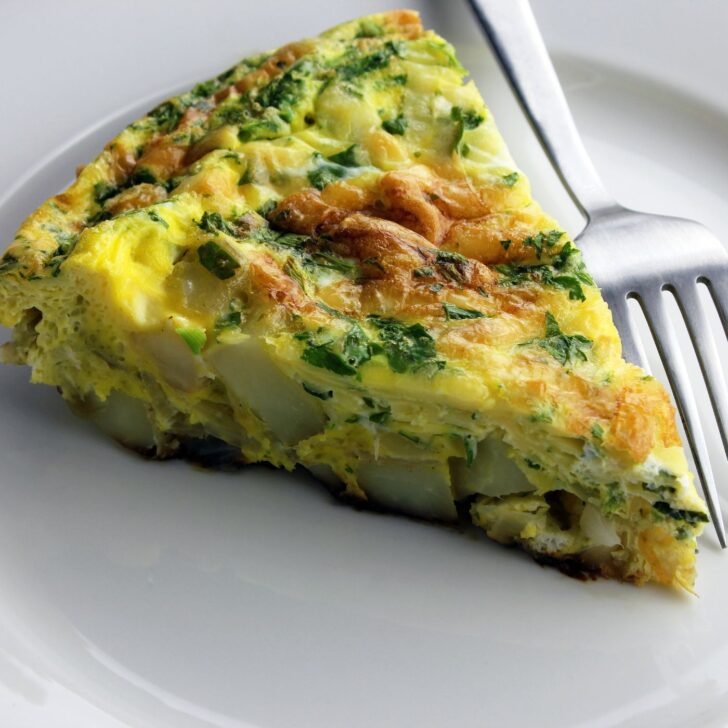Looking for the perfect kale frittata recipe? This Potato and Kale Frittata is a one-pan wonder that’s simple to make, packed with nutrients, and incredibly versatile. Whether you’re whipping up a quick breakfast, a light dinner, or a dish to impress at brunch, this recipe has you covered.
The combination of tender potatoes, earthy kale, and fluffy eggs, topped with savory Parmesan cheese, creates a satisfying meal that’s both wholesome and delicious. Plus, it’s naturally gluten-free, customizable, and perfect for using up ingredients you already have on hand.
Let’s dive into this easy recipe and uncover tips for making the perfect frittata every time!
Table of Contents

Potato and Kale Frittata
A hearty and flavorful dish, this Potato and Kale Frittata combines tender potatoes, earthy kale, and fluffy eggs, all topped with savory Parmesan cheese. Perfect for breakfast, brunch, or dinner, it’s easy to make, naturally gluten-free, and packed with nutrients!
Ingredients
- 2 c. Kale leaves, chopped
- 1 Tbsp Olive Oil
- 1 medium Onion, diced
- 1 clove Garlic, minced
- 2 medium Russet Potatoes, peeled and diced (or a bag of frozen country style hash browns)
- 6 large Eggs
- 1/2 c. Milk
- 1/4 c. Parmesan Cheese, shredded
- 1/4 tsp Salt
- Pinch Ground Pepper
Instructions
- Preheat oven to 425°F. Wash and pat dry the kale leaves.
- Heat olive oil in a 10-inch cast-iron skillet over medium heat. Add diced onion and minced garlic, and sauté until the onion is golden, about 10 minutes.
- Stir in the diced potatoes (or hash browns) and cover the skillet. Cook, stirring occasionally, until potatoes are tender, about 10-15 minutes.
- Add the kale to the skillet, cover, and cook for 5 minutes, until wilted.
In a bowl, whisk together eggs, milk, Parmesan cheese, salt, and pepper until well combined. - Pour the egg mixture evenly over the vegetables in the skillet.
- Bake uncovered for 15-20 minutes, or until the center is firm.
- Let stand for 5 minutes before slicing into wedges. Serve warm.
Recommended Products
As an Amazon Associate and member of other affiliate programs, I earn from qualifying purchases.
Nutrition Information
Yield 6 Serving Size 1 sliceAmount Per ServingCalories 191Total Fat 9gSaturated Fat 3gTrans Fat 0gUnsaturated Fat 5gCholesterol 190mgSodium 253mgCarbohydrates 18gFiber 2gSugar 3gProtein 11g
Instructions:
- Preheat and Prep
Preheat your oven to 425°F. Wash and pat dry the kale leaves. - Sauté the Aromatics
Heat the olive oil in a 10-inch cast-iron skillet over medium heat. Add the diced onion and minced garlic, and sauté until the onion is golden, about 10 minutes. - Cook the Potatoes
Stir in the diced potatoes (or hash browns) and cover the skillet. Cook for 10-15 minutes, stirring occasionally, until the potatoes are tender. - Wilt the Kale
Add the kale to the skillet, cover, and cook for about 5 minutes, until the leaves are wilted. - Prepare the Egg Mixture
In a separate bowl, whisk together the eggs, milk, Parmesan cheese, salt, and pepper until well combined. - Combine and Bake
Pour the egg mixture evenly over the vegetables in the skillet. Place the skillet in the oven and bake, uncovered, for 15-20 minutes, or until the center is firm. - Cool and Serve
Let the frittata rest for 5 minutes before slicing it into wedges. Serve warm and enjoy!

Why Kale is the Star of This Recipe
Kale isn’t just a trendy superfood—it’s an ingredient that takes this frittata to the next level. Here’s why:
Nutrient Powerhouse
Kale is packed with essential vitamins and minerals:
- Vitamin A for healthy vision and skin.
- Vitamin C to boost immunity.
- Vitamin K for strong bones and proper blood clotting.
Rich in Antioxidants
Kale is full of antioxidants like quercetin and kaempferol, which help combat inflammation and protect cells from damage.
High in Fiber
Fiber supports digestion and helps you feel full longer. By adding kale to this frittata, you create a balanced dish that satisfies hunger while supporting gut health.
Low-Calorie, Big Flavor
Despite its robust flavor, kale is low in calories, making it a perfect addition to meals that are both healthy and delicious. Its slightly bitter notes pair beautifully with the creamy eggs and savory Parmesan in this frittata.

Why Choose a Frittata?
Frittatas are more than just an egg dish—they’re a quick and versatile way to create a hearty meal.
What Makes a Frittata Different from an Omelet?
Unlike omelets, which are cooked quickly on the stovetop and folded around fillings, frittatas are thicker and more substantial. They’re cooked slowly, with the fillings mixed directly into the egg base, and finished in the oven for a golden, fluffy texture.
How Is a Frittata Different from a Quiche?
The biggest difference is the crust. While quiches have a pastry crust and are often made with rich cream, frittatas are crustless and lighter, making them quicker to prepare and naturally gluten-free.

Tips for the Perfect Frittata
A great frittata is more than just a mix of eggs and vegetables—it’s a beautifully balanced dish with the right texture, flavor, and appearance. Follow these tips to create a frittata that’s fluffy, flavorful, and perfectly cooked every time.
What Is a Good Ratio of Filling to Eggs?
For the ideal texture, aim for about ½ to 1 cup of filling per egg. This balance ensures the frittata holds together while still being packed with flavorful add-ins.
What Makes a Frittata Fluffy?
- Aerate the eggs: Whisk the eggs and milk until light and foamy to incorporate air, creating a tender texture.
- Even cooking: Baking the frittata in the oven ensures gentle, even cooking, avoiding rubbery or overcooked eggs.
Final Thoughts
This Potato and Kale Frittata is a simple yet delicious way to enjoy a meal that’s both nourishing and versatile. Whether you’re feeding your family, hosting brunch, or meal-prepping for the week, this recipe is a winner.
Your Turn to Try!
Gather your ingredients, grab your skillet, and get cooking. We’d love to see how your frittata turns out—share your photos or variations in the comments below!
For more easy, healthy recipes, subscribe to our newsletter for weekly inspiration delivered straight to your inbox.
Happy cooking!


